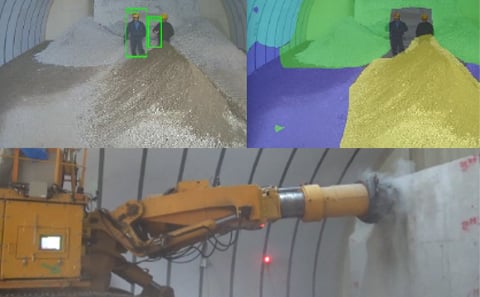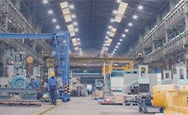POINT At MITSUI MIIKE MACHINERY, we are working to develop technologies that contribute to the realization of a "new way of manufacturing" incorporating the latest technologies. Utilizing AI and the IoT to advance information technology for industrial machinery, we create new value in areas such as promoting efficiency and reducing personnel at work sites and having centralized management and maintenance of equipment. We aim to continue being a company that can serve customers' interests.
Background to the research
Aiming to establish technologies that contribute to a "new way of manufacturing" incorporating the latest technologies
We at MITSUI MIIKE MACHINERY believe that in order to achieve self-sustainable growth and enhance our competitiveness in an era of rapid changes, we must aim to create products that are different from conventional ones while constantly incorporating new technologies. As part of this policy, we are developing technologies that make use of artificial intelligence (AI) and the Internet of things (IoT).
This initiative, which began in 2017, aims to build a system that will serve as the foundation for realizing Society 5.0 and implementing digital transformation (DX) among others by advancing information technology in industrial machinery. For example, our policy is to implement the following measures for various industrial machinery operated by customers.
- Integration of IoT data collection technology and AI-based data utilization/intellectualization technology (horizontal deployment)
- Establishment of a system to provide added value that matches the roles and applications of each machine (vertical development)
As the first step of this initiative, we are conducting research and development on automatic autonomous operation of road headers used in tunnel excavation work. In a typical road header, an electronic control system runs the hydraulic system and operates the machine’s cylinders and other mechanisms. In this research, we aim to enable AI to perform operations, such as hydraulic flow control, with an accuracy equivalent to that of a person, instead of having a human operator operate remotely.
Innovative efforts and challenges
Development of new underlying technologies from the ground up in consideration of future data analysis and utilization
In pursuing this research, we referred in part to the foregoing autonomous driving technology in the automobile industry. There are three basic technology areas in autonomous systems: recognition, judgment and control. For them, we referred to prevailing technologies applied in automobiles and software assets in the field of robotics, among others. Meanwhile, road headers weighing more than 50t operate at tunnel construction sites where GPS signals are hard to reach. In addition, during excavation, the body of the road header may be displaced due to the hardness of the rock. A number of hurdles had to be overcome to enable automatic excavation according to blueprints even under such conditions.
In addition, although we had some underlying technologies, such as sensor technology for cameras and program-driven machine control technology in-house, they were based on existing system configurations. In light of future AI-based data analysis and utilization, there was a need to build an efficient, scalable and simple system from scratch.
As such, we began by restructuring the Research and Development Dept. as a department handling research and development. We then gathered skilled personnel from each division, pursued integration with the Information Systems Gr. and took other steps. We also made progress in advancing simulation technology. A simulation process of simply converting a two-dimensional design drawing into three dimensions to examine mechanical interference cannot address the many situations that may occur when a road header is activated in an automated operation. Hence, we have enhanced the simulation accuracy by making the components of the road header as detailed as possible. We have defined them in modules and integrated them also with conditions of the tunnel excavation environment itself and an AI learning environment.
Results and future prospects
Aiming for future applications in efficiency improvement and manpower reduction at work sites and maintenance
At present, the research project on automatic autonomous operation of road headers is in the phase of being verified repeatedly and we are gradually accumulating underlying technologies as our expertise and assets. In our verification process, we start by using a model road header of a size that can be placed on a desk to verify automatic operation. Finally, we place the actual road header in a simulated tunnel about 20 meters long built in our factory to carry out verification assuming actual operation.
Furthermore, as part of our research activities, we were selected as an idea-oriented research member of RFP (Request for Proposal) for the Space Exploration Innovation Hub Center sponsored by JAXA (a National Research and Development Agency, the "Japan Aerospace Exploration Agency"). Participation in this was solicited publicly. We were engaged in joint research under the theme of "intellectualization of civil engineering work machines" over a period of about one year from 2018. We are also working with customers to develop heavy construction machines equipped with automatic operation functions and are preparing for operation at actual construction sites.
At MITSUI MIIKE MACHINERY, we are continuing with these research activities in an aim to increase efficiency and reduce manpower at work sites, centralize the management of operating machines, and apply technology to maintenance work. In addition, we hope our initiative will serve as a trigger to having a "new manufacturing culture for the future," which utilizes past assets more than ever, take root in the Company and lead that to consequently bringing about customer satisfaction.
Today, every company is expected to evolve in line with the times. It is also possible in the field of industrial machinery that we may lose our value as a company if we only manufacture products according to customer orders. Going forward, it is important that we proactively propose attractive products of high efficiency, high quality, and added value that meet the needs of the times based on new concepts that are different from conventional ones. We will continue our research activities in order to ultimately serve the interests of customers. We will do this by repeating steps starting from research on underlying technologies to commercialization and then to creating products that satisfy customers while incorporating the trends of the times such as DX.


